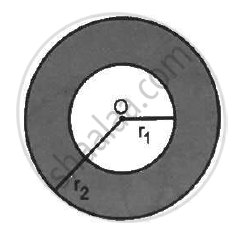Advertisements
Advertisements
प्रश्न
The electric field in a region is given by `vec"E" = ("E"_0 "x")/"l" vec"i".`
Find the charge contained inside the cubical volume bound by the surfaces
x =0, x =a, y=0, y=a, z=0 and z=a. Take
`"E"_0 = 5 xx 10^3 "N""C"^-1 , "l" =2 "cm" " and" " a" = 1 "cm" `
उत्तर
Given:
Electric field strength, `vec"E" = ("E"_0"x")/"l" hat"i"`
Length, l = 2 cm
Edge of the cube, a = 1 cm
E0 =5.0 × 103 N/C

It is observed that the flux passes mainly through the surfaces ABCD and EFGH. The surfaces AEFB and CHGD are parallel to the electric field. So, electric flux for these surfaces is zero.
The electric field intensity at the surface EFGH will be zero.
If the charge is inside the cube, then equal flux will pass through the two parallel surfaces ABCD and EFGH. We can calculate flux passing only through one surface. Thus,
`vec"E" = ("E"_0"x")/"l" hat"i"`
At EFGH, x = 0; thus, the electric field at EFGH is zero.
At ABCD, x = a; thus, the electric field at ABCD is ` vec"E" = ("E"_0"a")/"l" hat "i"`
The net flux through the whole cube is only through the side ABCD and is given by
`phi = vec"E" . vec "A" = (("E"_0"a")/"l" hat"i") . ("a" hat"i") = ("E"_0"a"^2)/"l".`
Net flux = `phi =( 5 xx 10^3)/( 2 xx 10^-2) xx ( 1 xx 10 ^-2)^2 "N""m"^2 // "C" = 2.5 "Nm"^2 // "C"`
Thus the net charge,
q = ∈0 `phi`
q = 8.85 × 10 -12 × 2.5
q =22.125 ×10-13
q =2.2125 ×10 -12 C
APPEARS IN
संबंधित प्रश्न
A charge Q is uniformly distributed over a large plastic plate. The electric field at a point P close to the centre of the plate is 10 V m−1. If the plastic plate is replaced by a copper plate of the same geometrical dimensions and carrying the same charge Q, the electric field at the point P will become
A metallic particle with no net charge is placed near a finite metal plate carrying a positive charge. The electric force on the particle will be
The electric field in a region is given by
`vec"E"= 3/5"E"_0 vec"i" + 4/5 "E"_0 vec "i" "with" " E"_0 = 2.0 xx 10^3 "N""C"^-1.`
Find the flux of this field through a rectangular surface of area 0⋅2 m2 parallel to the y-z plane.
A charge Q is placed at the centre of an imaginary hemispherical surface. Using symmetry arguments and Gauss's Law, find the flux of the electric field due to this charge through the surface of the hemisphere in the following figure.

The radius of a gold nucleus (Z = 79) is about 7.0 × 10-10 m. Assume that the positive charge is distributed uniformly throughout the nuclear volume. Find the strength of the electric field at (a) the surface of the nucleus and (b) at the middle point of a radius. Remembering that gold is a conductor, is it justified to assume that the positive charge is uniformly distributed over the entire volume of the nucleus and does not come to the outer surface?
A charge Q is distributed uniformly within the material of a hollow sphere of inner and outer radii r1 and r2 (see the figure). Find the electric field at a point P at a distance x away from the centre for r1 < x < r. Draw a rough graph showing the electric field as a function of x for 0 < x < 2r2 (see the figure).

Find the magnitude of the electric field at a point 4 cm away from a line charge of density 2 × 10-6 Cm-1.
A long cylindrical wire carries a positive charge of linear density 2.0 × 10-8 C m -1 An electron revolves around it in a circular path under the influence of the attractive electrostatic force. Find the kinetic energy of the electron. Note that it is independent of the radius.
A uniform electric field of 10 N C−1 exists in the vertically downward direction. Find the increase in the electric potential as one goes up through a height of 50 cm.
Consider a circular ring of radius r, uniformly charged with linear charge density λ. Find the electric potential at a point on the axis at a distance x from the centre of the ring. Using this expression for the potential, find the electric field at this point.
Draw equipotential surfaces corresponding to a uniform electric field in the z-directions.
Answer the following question.
Prove that the average energy density of the oscillating electric field is equal to that of the oscillating magnetic field.
A simple pendulum consists of a small sphere of mass m suspended by a thread of length l. The sphere carries a positive charge q. The pendulum is placed in a uniform electric field of strength E directed vertically downwards. Find the period of oscillation of the pendulum due to the electrostatic force acting on the sphere, neglecting the effect of the gravitational force.
Electric field at a point is defined as ______.
Pick out the statement which is incorrect
Two charged conducting spheres of radii a and b are connected to each other by a wire. Find the ratio of the electric fields at their surfaces.
